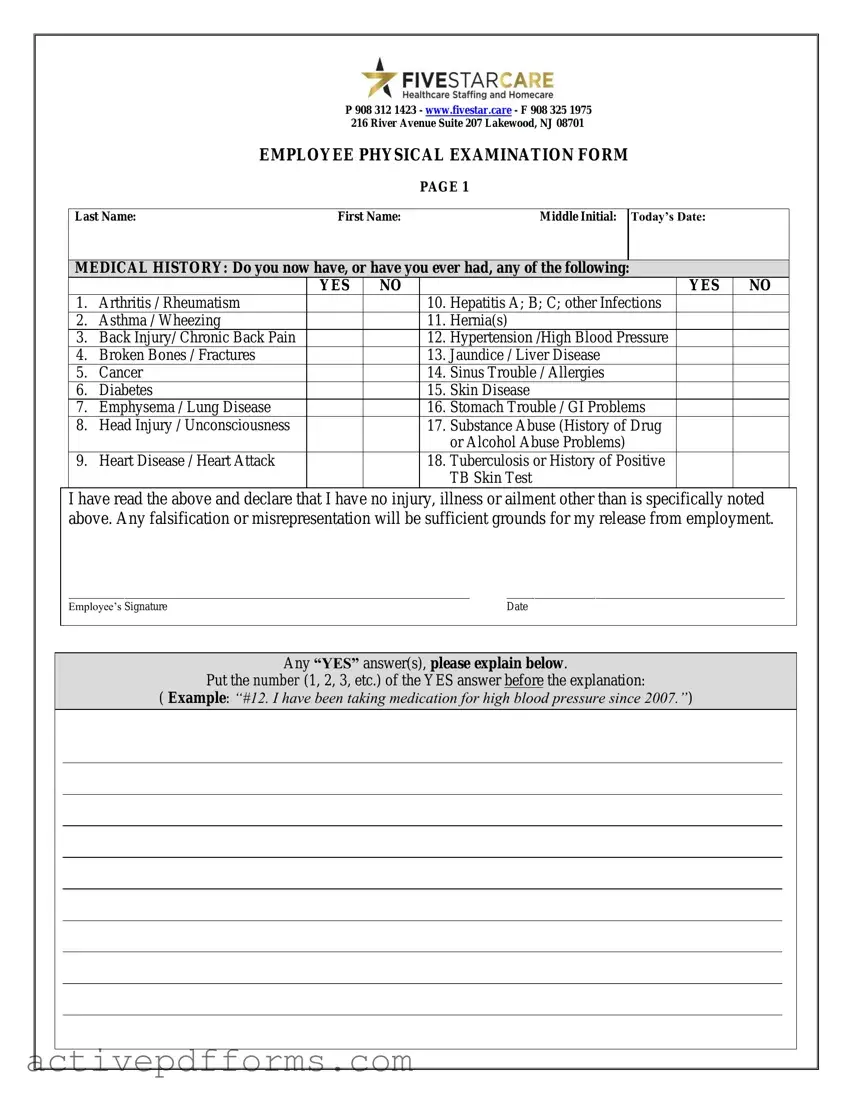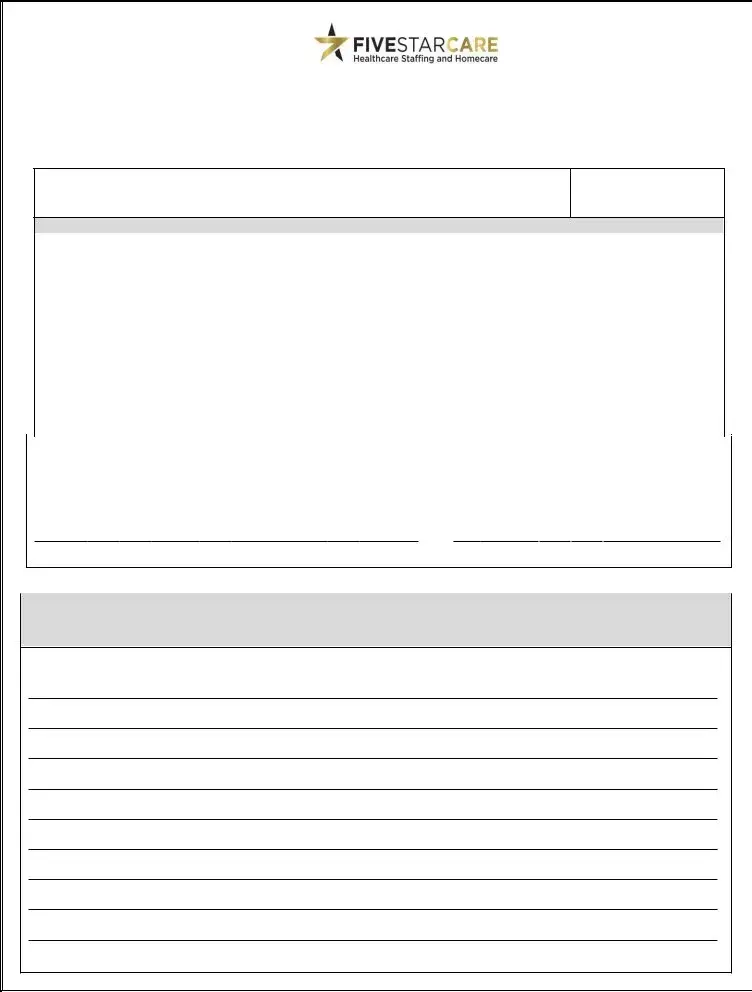P 908 312 1423 - www.fivestar.care - F 908 325 1975 216 River Avenue Suite 207 Lakewood, NJ 08701
EMPLOYEE PHYSICAL EXAMINATION FORM
PAGE 1
Last Name: |
First Name: |
Middle Initial: Today’s Date: |
MEDICAL HISTORY: Do you now have, or have you ever had, any of the following:
|
|
|
YES |
NO |
|
|
YES |
NO |
|
|
1. |
Arthritis / Rheumatism |
|
|
10. |
Hepatitis A; B; C; other Infections |
|
|
|
|
2. |
Asthma / Wheezing |
|
|
11. |
Hernia(s) |
|
|
|
|
3. |
Back Injury/ Chronic Back Pain |
|
|
12. |
Hypertension /High Blood Pressure |
|
|
|
|
4. |
Broken Bones / Fractures |
|
|
13. Jaundice / Liver Disease |
|
|
|
|
5. |
Cancer |
|
|
14. |
Sinus Trouble / Allergies |
|
|
|
|
6. |
Diabetes |
|
|
15. |
Skin Disease |
|
|
|
|
7. |
Emphysema / Lung Disease |
|
|
16. |
Stomach Trouble / GI Problems |
|
|
|
|
8. |
Head Injury / Unconsciousness |
|
|
17. |
Substance Abuse (History of Drug |
|
|
|
|
|
|
|
|
|
or Alcohol Abuse Problems) |
|
|
|
|
9. |
Heart Disease / Heart Attack |
|
|
18. |
Tuberculosis or History of Positive |
|
|
|
|
|
|
|
|
|
TB Skin Test |
|
|
|
I have read the above and declare that I have no injury, illness or ailment other than is specifically noted above. Any falsification or misrepresentation will be sufficient grounds for my release from employment.
Employee’s Signature |
Date |
Any “YES” answer(s), please explain below.
Put the number (1, 2, 3, etc.) of the YES answer before the explanation:
( Example: “#12. I have been taking medication for high blood pressure since 2007.”)
P 908 312 1423 - www.fivestar.care - F 908 325 1975 216 River Avenue Suite 207 Lakewood, NJ 08701
EMPLOYEE PHYSICAL EXAMINATION FORM
PAGE 2
Last Name: |
|
|
|
|
|
|
|
First Name: |
|
|
|
|
Middle Initial: |
|
Today’s Date: |
|
Job Title: |
|
|
|
|
|
|
|
|
|
|
|
|
|
|
|
|
|
|
|
|
|
|
|
|
|
|
|
|
|
DOB |
|
Age |
|
Sex |
|
HT |
|
WT |
|
Temp. |
Pulse |
Resp. |
|
B/P |
|
Drug/Food Allergies |
|
|
|
|
|
|
|
|
|
|
|
|
|
|
|
|
|
|
|
|
Vision: R 20/ |
|
|
L 20/ |
|
Pupils: Equal |
|
Unequal Glasses/Lenses: Y / N |
Hearing: Normal Impaired Hearing Aid |
|
|
|
|
|
|
|
|
|
|
|
|
|
|
|
|
|
|
PHYSICAL EXAM |
|
|
|
NORMAL |
|
ABNORMAL |
|
|
|
COMMENTS |
1. |
General Appearance / BMI |
|
|
|
|
|
|
|
|
|
|
|
|
|
|
|
|
|
|
|
|
|
|
|
|
|
|
|
|
|
|
|
|
|
|
|
|
|
|
|
|
|
|
|
|
|
2. |
Skin |
|
|
|
|
|
|
|
|
|
|
|
|
|
|
|
|
|
|
|
|
|
|
|
|
|
|
|
|
|
|
|
|
|
|
|
|
|
|
|
|
|
|
|
|
|
|
|
|
|
|
3. |
HEENT |
|
|
|
|
|
|
|
|
|
|
|
|
|
|
|
|
|
|
|
|
|
|
|
|
|
|
|
|
|
|
|
|
|
|
|
|
|
|
|
|
|
|
|
|
|
|
|
|
|
|
4. |
Teeth |
|
|
|
|
|
|
|
|
|
|
|
|
|
|
|
|
|
|
|
|
|
|
|
|
|
|
|
|
|
|
|
|
|
|
|
|
|
|
|
|
|
|
|
|
|
|
|
|
|
|
5. |
Neck |
|
|
|
|
|
|
|
|
|
|
|
|
|
|
|
|
|
|
|
|
|
|
|
|
|
|
|
|
|
|
|
|
|
|
|
|
|
|
|
|
|
|
|
|
|
|
|
|
|
|
6. |
Lungs |
|
|
|
|
|
|
|
|
|
|
|
|
|
|
|
|
|
|
|
|
|
|
|
|
|
|
|
|
|
|
|
|
|
|
|
|
|
|
|
|
|
|
|
|
|
|
|
|
|
|
7. |
Heart |
|
|
|
|
|
|
|
|
|
|
|
|
|
|
|
|
|
|
|
|
|
|
|
|
|
|
|
|
|
|
|
|
|
|
|
|
|
|
|
|
|
|
|
|
|
|
|
|
|
|
8. |
Abdomen |
|
|
|
|
|
|
|
|
|
|
|
|
|
|
|
|
|
|
|
|
|
|
|
|
|
|
|
|
|
|
|
|
|
|
|
|
|
|
|
|
|
|
|
|
|
|
|
|
|
|
9. |
GU System |
|
|
|
|
|
|
|
|
|
|
|
|
|
|
|
|
|
|
|
|
|
|
|
|
|
|
|
|
|
|
|
|
|
|
|
|
|
|
|
|
10. Musculoskeletal Functioning |
|
|
|
|
|
|
|
|
|
|
|
|
|
|
|
(Full ROM to all extremities? History |
|
|
|
|
|
|
|
|
|
|
|
|
|
|
|
of injury to knees or hips?) |
|
|
|
|
|
|
|
|
|
|
|
|
|
|
|
|
|
|
|
|
11. Back / Spine (History of injury?) |
|
|
|
|
|
|
|
|
|
|
|
|
|
|
|
|
|
|
|
|
|
|
|
|
|
|
|
|
|
|
|
12. Neurological (Gross observation |
|
|
|
|
|
|
|
|
|
|
|
|
|
|
|
of gait, coordination, tremors, etc.) |
|
|
|
|
|
|
|
|
|
|
|
|
|
|
|
|
|
|
|
|
|
|
|
|
|
|
|
|
|
|
|
13. Psychiatric (tics, stuttering, nail- |
|
|
|
|
|
|
|
|
|
|
|
|
|
|
|
biting, cognition, orientation, affect, |
|
|
|
|
|
|
|
|
|
|
|
|
|
|
|
obvious personality disorders, etc.) |
|
|
|
|
|
|
|
|
|
|
|
|
|
|
|
Physician’s review of person’s medical history as recorded on reverse side of this form:
|
|
|
|
|
|
|
|
|
|
|
|
|
|
|
|
|
PPD / Mantoux Test for Tuberculosis: 1st Step Date: |
|
|
|
_ Result: |
_ 2nd Step Date: |
Result: |
|
Chest X-Ray: Date Performed: |
|
|
Results: |
|
|
|
|
|
|
|
|
|
|
|
|
|
|
|
|
|
|
|
|
|
THIS APPLICANT IS FIT FOR EMPLOYMENT: YES: |
|
|
|
|
NO: |
|
|
Deferred for Functional Capacity Evaluation: |
|
|
|
|
|
|
|
|
Examining Physician’s Signature |
|
Date Physical Examination Performed |


